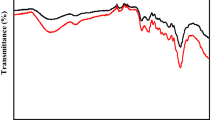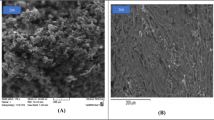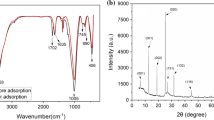Abstract
The adsorption process is one of the most promising alternatives for textile effluent treatment. Different materials have been used as adsorbents and most of them present hard recovery, increasing the process cost. In this work, polyethylene terephthalate (PET) waste bottles were used as a substrate for the formation of titanium dioxide (TiO2-G5) films aiming at Reactive Black 5 removal by adsorption process. The TiO2-G5/PET films were characterized by N2 adsorption-desorption, zeta potential analysis, X-ray diffraction (XRD), and adherence test. The pH, adsorbent charge, and stirring effects were investigated. Initially, the effects of the adsorbent mass, pH of the solution, and stirring were studied, obtaining a maximum adsorptive capacity of 155.04 mg g−1 in the greatest condition (4 mg, pH = 4 and no stirring). The experimental data were fitted by the Langmuir and Freundlich isotherms. The Langmuir model presented the greatest fit, evidencing monolayer adsorption for this process. The kinetic study showed a great fit between the adsorption process and the pseudo-first-order kinetic model, which presented a correlation coefficient of 0.982. The thermodynamic parameters—enthalpy (∆H = − 19.53 kJ mol−1), entropy (∆S = − 50.26 J mol−1 K−1), and Gibbs energy (− 5.31, − 4.80, and − 4.30 kJ mol−1 at 283.15 K, 293.15 K, and 303.15 K, respectively)—indicate a spontaneous and exothermic process. Finally, the regeneration by solar radiation exposure led to an efficient TiO2-G5/PET spent sheets recovery, exhibiting good stability after 5 cycles of use.

Graphical abstract










Similar content being viewed by others
References
Abdel-Fatah, M. A., Hafez, A. I., Gaber, A. H., & Kamal, M. (2019). Alternative solutions of industrial wastewater management in the textile industry. Journal of Petroleum Science and Engineering, 4, 90–95.
Aguero, F. N., Barbero, B. P., Almeida, L. C., Montes, M., & Cadús, L. E. (2011). MnOx supported on metallic monoliths for the combustion of volatile organic compounds. Chemical Engineering Journal. https://doi.org/10.1016/j.cej.2010.10.064.
Alfaia, R. G. S. M., Costa, A. M., Campos, J. C., (2017). Municipal solid waste in Brazil: A review. Waste Management & Research: SAGE Journals, https://doi.org/10.1177/0734242X17735375.
Alias, S. S., Harun, Z., Azhar, F. H., Ibrahim, S. A., & Johar, B. (2020). Comparison between commercial and synthesised nano flower-like rutile TiO2 immobilised on green super adsorbent towards dye wastewater treatment. Journal of Cleaner Production. https://doi.org/10.1016/j.jclepro.2019.119448.
Aljeboree, A. M., Alshirifi, A. N., & Alkaim, A. F. (2017). Kinetics and equilibrium study for the adsorption of textile dyes on coconut shell activated carbon. Arabian Journal of Chemistry. https://doi.org/10.1016/j.arabjc.2014.01.020.
Almeida, L. C., Echave, F. J., Sanz, O., Centeno, M. A., Arzamendi, G., Gandía, L. M., et al. (2011). Fischer-Tropsch synthesis in microchannels. Chemical Engineering Journal. https://doi.org/10.1016/j.cej.2010.09.091.
Askarniya, Z., Sadeghi, M. T., Baradaran, S., (2020). Decolorization of Congo red via hydrodynamic cavitation in combination with Fenton’s reagent. Chemical Engineering and Processing: Process Intensification, https://doi.org/10.1016/j.cep.2020.107874.
Benkhaya, S., M’Rabet, S., & El Harfi, A. (2020). Classifications, properties, recent synthesis and applications of azo dyes. Heliyon. https://doi.org/10.1016/j.heliyon.2020.e03271.
Bouraie, M., & El Din, W. S. (2016). Biodegradation of Reactive Black 5 by Aeromonas hydrophila strain isolated from dye-contaminated textile wastewater. Sustainable Environment Research. https://doi.org/10.1016/j.serj.2016.04.014.
Cardoso, N. F., Pinto, R. B., Lima, E. C., Calvete, T., Amavisca, C. V., Royer, B., et al. (2011). Removal of Remazol Black B textile dye from aqueous solution by adsorption. Desalination. https://doi.org/10.1016/j.desal.2010.10.047.
Chen, A. H., & Huang, Y. Y. (2010). Adsorption of Remazol Black 5 from aqueous solution by the template crosslinked-chitosans. Journal of Hazardous Materials. https://doi.org/10.1016/j.jhazmat.2009.12.083.
Conrad, E. K., Nnaemeka, O. J., Uchechi, E. E., Basil, A., Veronica, O. O., Cynthia, O. E., et al. (2016). Adsorption of Congo red dye from aqueous solution using agricultural waste. IOSR Journal of Applied Chemistry, 9, 39–51.
Cotillas, S., Clematis, D., Cañizares, P., Carpanese, M. P., Rodrigo, M. A., & Panizza, M. (2018). Degradation of dye Procion Red MX-5B by electrolytic and eletroirradiated technologies using diamond electrodes. Chemosphere. https://doi.org/10.1016/j.chemosphere.2018.02.001.
Dastkhoon, M., Ghaedi, M., Asfaram, A., Azqhandi, M. H. A., & Purkait, M. K. (2017). Simultaneous removal of dyes onto nanowires adsorbent use of ultrasound assisted adsorption to clean waste water: Chemometrics for modeling and optimization, multicomponent adsorption and kinetic study. Chemical Engineering Research and Design. https://doi.org/10.1016/j.cherd.2017.06.011.
Değermenci, G. D., Değermenci, N., Ayvaoglu, V., Durmaz, E., Çakir, D., & Akan, E. (2019). Adsorption of reactive dyes on lignocellulosic waste; characterization, equilibrium, kinetic and thermodynamic studies. Journal of Cleaner Production. https://doi.org/10.1016/j.jclepro.2019.03.260.
Demirel, B., Yaras, A., & Elçiçek, H. (2011). Crystallization behavior of PET materials. Balıkesir Üniversitesi Fen Bilimleri Enstitüsü Dergisi, 13, 26–35.
Dhanke, P. B., & Wagh, S. M. (2020). Intensification of the degradation of Acid Red-18 using hydrodynamic cavitation. Emerging Contaminants. https://doi.org/10.1016/j.emcon.2019.12.001.
Dotto, G. L., Vieira, M. L. G., Gonçalves, J. O., Pinto, L. A. A., (2011). Removal of acid blue 9, food yellow 3 and FD&C yellow n° 5 dyes from aqueous solutions using activated carbon, activated earth, diatomaceous earth, chitin and chitosan: Equilibrium studies and thermodynamic. Química Nova, https://doi.org/10.1590/S0100-40422011000700017.
Gita, S., Hussan, A., & Choudhury, T. G. (2017). Impact of textile dyes waste on aquatic environments and its treatment. Environment and Ecology, 35, 2349–2353.
Hossen, M. Z., Hussain, E., Hakim, A., Islam, K., Uddin, M. N., & Azad, A. K. (2019). Biodegradation of reactive textile dye Novacron Super Black G by free cells of newly isolated Alcaligenes faecalis AZ26 and Bacillus spp. obtained from textile effluents. Heliyon. https://doi.org/10.1016/j.heliyon.2019.e02068.
Ibrahim, M. M. (2019). Cr2O3/Al2O3 as adsorbent: Physicochemical properties and adsorption behaviors towards removal of Congo red dye from water. Journal of Environmental Chemical Engineering. https://doi.org/10.1016/j.jece.2018.102848.
Jain, S. N., Tamboli, S. R., Sutar, D. S., Jadhav, S. R., Marathe, J. V., Shaikh, A. A., et al. (2020). Batch and continuous studies for adsorption of anionic dye onto waste tea residue: Kinetic, equilibrium, breakthrough and reusability studies. Journal of Cleaner Production. https://doi.org/10.1016/j.jclepro.2019.119778.
Jamee, R., & Siddique, R. (2019). Biodegradation of synthetic dyes of textile effluent by microorganisms: An environmentally and economically sustainable approach. European Journal of Microbiology and Immunology. https://doi.org/10.1556/1886.2019.00018.
Jaseela, P. K., Garvasis, J., & Joseph, A. (2019). Selective adsorption of methylene blue (MB) dye from aqueous mixture of MB and methyl orange (MO) using mesoporous titania (TiO2) – Poly vinyl alcohol (PVA) nanocomposite. Journal of Molecular Liquids. https://doi.org/10.1016/j.molliq.
Karaoğlu, M. H., Doğan, M., & Alkan, M. (2010). Removal of reactive blue 221 by kaolinite from aqueous solutions. Industrial & Engineering Chemistry Research. https://doi.org/10.1021/ie9017258.
Khataee, A., & Mansoori, G. A. (2012). Nanostructured titanium dioxide materials: Properties, preparation and applications. Singapore: World Scientific.
Konicki, W., Aleksandrzak, M., & Mijowska, E. (2017). Equilibrium, kinetic and thermodynamic studies on adsorption of cationic dyes from aqueous solutions using graphene oxide. Chemical Engineering Research and Design. https://doi.org/10.1016/j.cherd.2017.03.036.
Kumar, K. Y., Muralidhara, H. B., Nayaka, Y. A., Balasubramanyam, J., & Hanumanthappa, H. (2013). Low-cost synthesis of metal oxide nanoparticles and their application in adsorption of commercial dye and heavy metal ion in aqueous solution. Powder Technology. https://doi.org/10.1016/j.powtec.2013.05.017.
Langmiur, I. (1918). The adsorption of gases on plane surfaces of glass, mica and platinum. Journal of the American Chemical Society. https://doi.org/10.1021/ja02242a004.
Largitte, L., & Pasquier, R. (2016). A review of the kinetics adsorption models and their application to the adsorption of lead by an activated carbon. Chemical Engineering Research and Design. https://doi.org/10.1016/J.CHERD.2016.02.006.
Lau, Y. Y., Wong, Y. S., Teng, T. T., Morad, N., Rafatullah, M., & Ong, S. A. (2015). Degradation of cationic and anionic dyes in coagulation-flocculation process using bi-functionalized silica hybrid with aluminum-ferric as auxiliary agent. RSC Advances. https://doi.org/10.1039/C5RA01346A.
Laysandra, L., Sari, M. W. M. K., Soetaredjo, F. E., Foe, K., Putro, J. N., Kurniawan, A., Ju, Y., et al. (2017). Adsorption and photocatalytic performance of bentonite-titanium dioxide composites for methylene blue and rhodamine B decoloration. Heliyon. https://doi.org/10.1016/j.heliyon.2017.e00488.
Li, Y. F., Zhang, W. P., Li, X., & Yu, Y. (2014). TiO2 nanoparticles with high ability for selective adsorption and photodegradation of textile dyes under visible light by feasible preparation. Journal of Physics and Chemistry of Solids. https://doi.org/10.1016/j.jpcs.2013.08.012.
Lino, F. A. M., & Ismail, K. A. R. (2012). Analysis of the potential of municipal solid waste in Brazil. Environmental Development. https://doi.org/10.1016/j.envdev.2012.08.005.
Madan, S., Shaw, R., Tiwari, S., & Tiwari, S. K. (2019). Adsorption dynamics of Congo red dye removal using ZnO functionalized high silica zeolitic particles. Applied Surface Science. https://doi.org/10.1016/j.apsusc.2019.04.273.
Mahyar, A., & Amani-Ghadim, A. (2011). Influence of solvent type on the characteristics and photocatalytic activity of TiO2 nanoparticles prepared by the sol-gel method. Micro & Nano Letters. https://doi.org/10.1049/mnl.2011.0058.
Marcelino, R. B. P., Amorin, C. C., Ratova, M., Delfour-Peyrethon, B., & Kelly, P. (2019). Novel and versatile TiO2 thin films on PET for photocatalytic removal of contaminants of emerging concern from water. Chemical Engineering Journal. https://doi.org/10.1016/j.cej.2019.03.284.
Masuda, Y., Bekki, M., Sonezaki, S., Ohji, T., & Kato, K. (2009). Dye adsorption characteristics of anatase TiO2 film prepared in an aqueous solution. Thin Solid Films. https://doi.org/10.1016/j.tsf.2009.07.101.
Meichtry, J.M., Lin, H.J., La Fuente,L., Litter, M.I., (2007). Low-cost TiO2 photocatalytic technology for water potabilization in plastic bottles for isolated regions. Photocatalyst fixation. Journal of Solar Energy Engineering, https://doi.org/10.1115/1.2391317.
Miaralipour, S., Friedmann, D., Scott, J., & Amal, R. (2018). TiO2/porous adsorbents: Recent advances and novel applications. Journal of Hazardous Materials. https://doi.org/10.1016/j.jhazmat.2017.07.070.
Mohamed, R. M., Shawky, A., & Mkhalid, I. A. (2017). Facile synthesis of MgO and Ni-MgO nanostructures with enhanced adsorption of methyl blue dye. Journal of Physics and Chemistry of Solids. https://doi.org/10.1016/j.jpcs.2016.10.009.
Mohammadi, R., & Mohammadi, M. (2015). Photocatalytic removal of methyl orange using Ag/Zn–TiO2 nanoparticles prepared by different methods. Desalination and Water Treatment. https://doi.org/10.1080/19443994.2015.1041160.
Moma, J., & Baloyi, J. (2018). Modified titanium dioxide for photocatalytic applications. Photocatalysts - Applications and Attributes. https://doi.org/10.5772/intechopen.79374.
Muruganandham, M., Sobana, N., & Swaminathan, M. (2006). Solar assisted photocatalytic and photochemical degradation of Reactive Black 5. Journal of Hazardous Materials. https://doi.org/10.1016/j.jhazmat.2006.03.030.
Nascimento, R. F., Lima, A. C. A., Vidal, C. B., Melo, D. Q., & Raulino, G. S. C. (2014). Adsorção: Aspecto teórico e aplicações ambientais. Fortaleza: Imprensa Universitária.
Naushad, M., Khan, M. A., Alotheman, Z. A., Kan, M. R., & Kumar, M. (2015). Adsorption of methylene blue on chemically modified pine nut shells in single and binary systems: Isotherms, kinetics, and thermodynamic studies. Desalination and Water Treatment. https://doi.org/10.1080/19443994.2015.1074121.
Nogueira, R. F. P., Jardim, W. F., (1998). Heterogeneous photocatalysis and its environmental. Química Nova. https://doi.org/10.1590/S0100-40421998000100011\.
Ooi, J., Lee, L. Y., Hiew, B. Y. Z., Thangalazhy-Gopakumar, S., Lim, S. S., & Gan, S. (2017). Assessment of fish scales waste as a low cost and eco-friendly adsorbent for removal of an azo dye: Equilibrium, kinetic and thermodynamic studies. Bioresource Technology. https://doi.org/10.1016/j.biortech.2017.08.153.
Pei, Y., Chu, S., Chen, Y., Li, Z., Zhao, J., Liu, S., et al. (2017). Tannin-immobilized cellulose hydrogel fabricated by a homogeneous reaction as a potential adsorbent for removing cationic organic dye from aqueous solution. International Journal of Biological Macromolecules. https://doi.org/10.1016/j.ijbiomac.2017.05.072.
Pieczyńska, A., Ossowski, T., & Siedlecka, E. (2019). Electrochemical degradation of textile dyes in a flow reactor: Effect of operating conditions and dyes chemical structure. International journal of Environmental Science and Technology. https://doi.org/10.1007/s13762-018-1704-0.
Pizato, E., Lopes, A. C., Rocha, R. D. C., Barbosa, A. M., & Cunha, M. A. A. (2017). Caracterização de efluente têxtil e avaliação da capacidade de remoção de cor utilizando o fungo Lasiodiplodiatheobromae MMPI. Sanitary Engineering Journal. https://doi.org/10.1590/s1413-41522017121743.
Rajumon, R., Anand, J. C., Ealias, A. M., Desai, D. S., George, G., & Saravanakumar, M. P. (2019). Adsorption of textile dyes with ultrasonic assistance using green reduced graphene oxide: An in-depth investigation on sonochemical factors. Journal of Environmental Chemical Engineering. https://doi.org/10.1016/j.jece.2019.103479.
Ribeiro, L. N., Fonseca, A. C. S., Silva, E. F. M., Oliveira, E. D. C., Ribeiro, A. T. S., Maranhão, L. C. A., et al. (2020). Residue-based TiO2/PET photocatalytic films for the degradation of textile dyes: A step in the development of green monolith reactors. Chemical Engineering and Processing: Process Intensification. https://doi.org/10.1016/j.cep.2019.107792.
Sadegh, H., Ali, G. A. M., Gupta, V. K., Makhlouf, A. S. H., Shahryari-ghoshelandi, R., Nadagouda, M. N., et al. (2017). The role of nanomaterials as effective adsorbents and their applications in wastewater treatment. Journal of Nanostructure in Chemistry. https://doi.org/10.1007/s40097-017-0219-4.
Sahel, K., Perol, N., Chermette, H., Bordes, C., Derriche, Z., & Guillard, C. (2007). Photocatalytic decolorization of Remazol Black 5 (RB5) and Procion Red MX-5B—Isotherm of adsorption, kinetic of decolorization and mineralization. Applied Catalysis B: Environmental. https://doi.org/10.1016/j.apcatb.2007.06.016.
Salazar, R., Ureta-Zañartua, S. M., González-Vargas, C., Brito, C. N., & Martinez-Huitle, C. A. (2018). Electrochemical degradation of industrial textile dye disperse yellow 3: Role of electrocatalytic material and experimental conditions on the catalytic production of oxidants and oxidation pathway. Chemosphere. https://doi.org/10.1016/j.chemosphere.2017.12.092.
Sangon, S., Hunt, A. J., Attard, T. M., Mengchang, P., Ngernyen, Y., & Supanchaiyamat, N. (2018). Valorisation of waste rice straw for the production of highly effective carbon based adsorbents for dyes removal. Journal of Cleaner Production. https://doi.org/10.1016/j.jclepro.2017.10.210.
Shabaan, O. A., Jahin, H. S., & Mohamed, G. G. (2020). Removal of anionic and cationic dyes from wastewater by adsorption using multiwall carbon nanotubes. Arabian Journal of Chemistry. https://doi.org/10.1016/j.arabjc.2020.01.010.
Shaheed, M. A., & Hussein, F. H. (2014). Adsorption of Reactive Black 5 on synthesized titanium dioxide nanoparticles: Equilibrium isotherm and kinetic studies. Journal of Nanomaterials. https://doi.org/10.1155/2014/198561.
Sharma, S. K., Brunia, H., & Bajpai, P. K. (2012). Photocatalytic decolorization kinetics and mineralization of Reactive Black 5 aqueous solution by UV/TiO2 nanoparticles. Clean – Soil, Air, Water. https://doi.org/10.1002/clen.201100557.
Shi, Z., Lai, H., Yao, S., & Whang, S. (2012). Preparation, characterization and photocatalytic activity of lanthanum doped mesoporous titanium dioxide. Chinese Journal of Chemical Physics. https://doi.org/10.1088/1674-0068/25/01/96-102.
Singha, J., Sahu, K., Satpati, B., Shah, J., Kotnala, R. K., & Mohapatra, S. (2019). Facile synthesis, structural and optical properties of au-TiO2 plasmonic nanohybrids for photocatalytic applications. Journal of Physical Chemistry. https://doi.org/10.1016/j.jpcs.2019.109100.
Sun, D., Zhang, X., Wu, Y., & Liu, X. (2010). Adsorption of anionic dyes from aqueous solution on fly ash. Journal of Hazardous Materials. https://doi.org/10.1016/j.jhazmat.2010.05.015.
Tatarchuk, T., Mironyuk, I., Kotsyubynsky, V., Shyichuk, A., Myslin, M., & Boychuk, V. (2017). Structure, morphology and adsorption properties of titania shell immobilized onto cobalt ferrite nanoparticle core. Journal of Molecular Liquids. https://doi.org/10.1016/j.molliq.2019.111757.
The Guardian (2017). A million bottles a minute: World’s plastic binge ‘as dangerous as climate change’.https://www.theguardian.com/environment/2017/jun/28/a-million-a-minute-worlds-plastic-bottle-binge-as-dangerous-as-climate-change. Accessed 01 May 2020.
Thommes, M., Kaneko, K., Neimark, A. V., Olivier, J. P., Rodriguez-Reinoso, F., Rouquerol, J., & Sing, K. S. W. (2015). Physisorption of gases, with special reference to the evaluation of surface area and pore size distribution (IUPAC technical report). Pure and Applied Chemistry. https://doi.org/10.1515/pac-2014-1117.
Ujile, A. A. (2014). Chemical engineering unit operations, synthesis and basic design calculations (1st ed.). Ibadan: Bomn Publishers, Ibadan Nigeria.
Vallar, S., Houivet, D., El Fallah, J., Kervadec, D., & Haussonne, J.-M. (1999). Oxide slurries stability and powders dispersion. Optimization with zeta potential and rheological measurements. Journal of the European Ceramic Society. https://doi.org/10.1016/S0955-2219(98)00365-3.
Ventura-Camargo, B. D. C., & Marin-Morales, M. A. (2015). Azo dyes: Characterization and toxicity– A review. Textiles and Light Industrial Science and Technology, 2, 85–103.
Wang, R., Cai, X., & Shen, F. (2014). TiO2 hollow microspheres with mesoporous surface: Superior adsorption performance for dye removal. Applied Surface Science. https://doi.org/10.1016/j.apsusc.2014.03.089.
Zafar, M. N., Dar, Q., Nawaz, F., Zafar, M. N., Iqbal, M., & Nazar, M. F. (2019). Effective adsorptive removal of azo dyes overspherical ZnO nanoparticles. Journal of Materials Research and Technology. https://doi.org/10.1016/j.jmrt.2018.06.002.
Zhang, F., Chen, X., Wu, F., & Ji, Y. (2016). High adsorption capability and selectivity of ZnO nanoparticles for dye removal. Colloids and Surfaces A: Physicochemical and Engineering Aspects. https://doi.org/10.1016/j.colsurfa.2016.09.059.
Zulfiqar, M., Chowdhury, S., Sufian, S., & Omar, A. A. (2018). Enhanced photocatalytic activity of orange II in aqueous solution using solvent-based TiO2 nanotubes: Kinetic, equilibrium and thermodynamic studies. Journal of Cleaner Production. https://doi.org/10.1016/j.jclepro.2018.08.324.
Acknowledgments
This work was supported by the FACEPE [Project APQ-0073-3.06/17].
Author information
Authors and Affiliations
Corresponding author
Additional information
Publisher’s Note
Springer Nature remains neutral with regard to jurisdictional claims in published maps and institutional affiliations.
Rights and permissions
About this article
Cite this article
Santos, R., Silva, É.F.M., Dantas, E.J.M. et al. Potential Reuse of PET Waste Bottles as a Green Substrate/Adsorbent for Reactive Black 5 Dye Removal. Water Air Soil Pollut 231, 533 (2020). https://doi.org/10.1007/s11270-020-04901-7
Received:
Accepted:
Published:
DOI: https://doi.org/10.1007/s11270-020-04901-7




